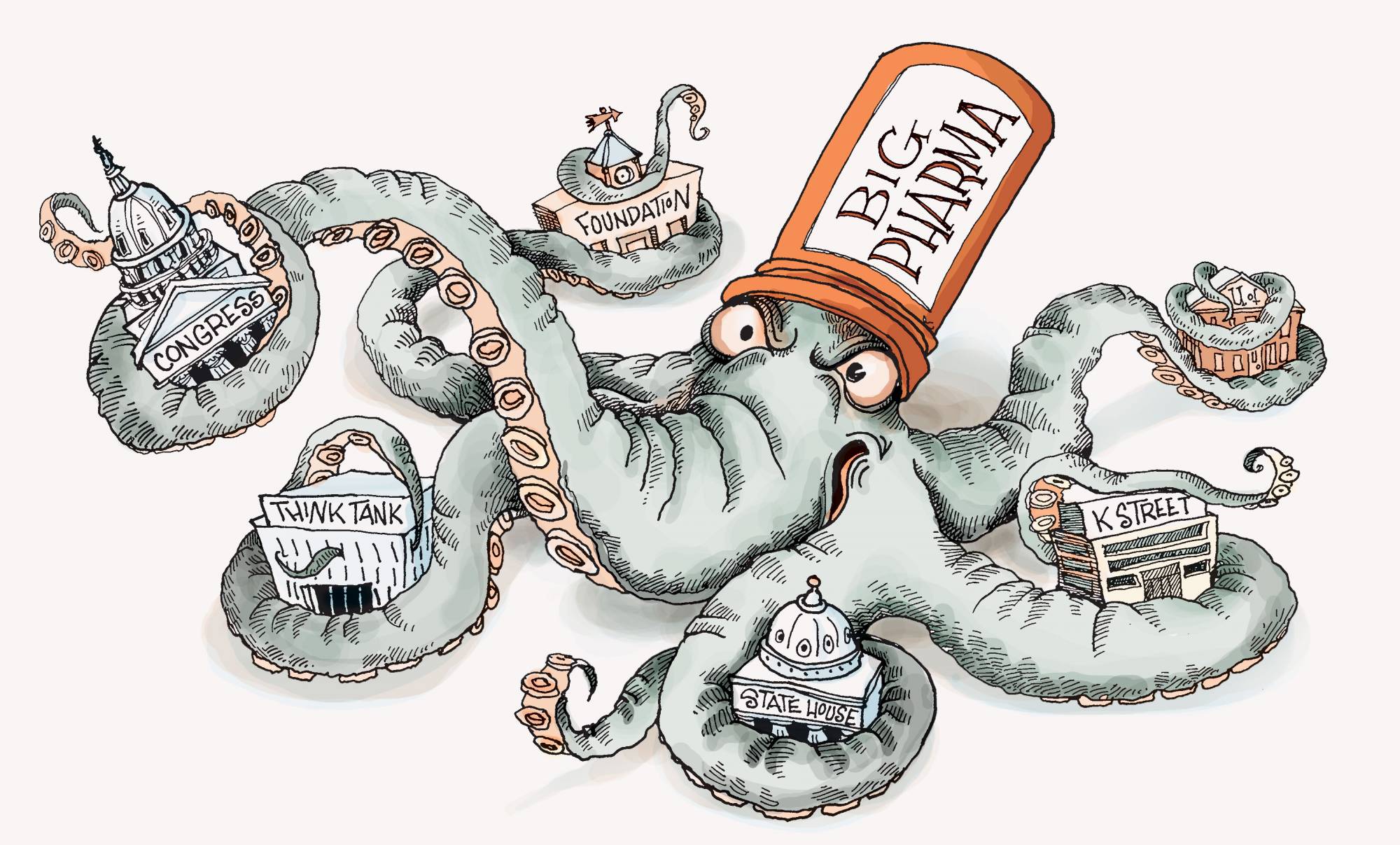
By Jon Hellevig,
The United States runs the by far biggest and most bloated healthcare sector in the world when measured as a share of the total economy. Its annual value was $3.7 trillion, amounting to 17.9% of GDP (2018). That is nearly double the average of developed Western countries (as a share of GDP). The enormous expense does not buy Americans any better health than the Europeans get for half the price, in fact the health outcomes are far inferior in the US. In life expectancy, the US has fallen down to 33rd place, even overtaken by Cuba.
Exorbitant prices on drugs, medical treatment and health insurances are crushing consumers. Half of working age American adults have either no insurance at all or only an inadequate insurance and therefore risk being financially ruined for any kind of medical treatment – even just checking in at a hospital and leaving the same day could land you with a five-figure bill. Studies have shown that two-thirds of Americans are not able to afford a $500 unexpected cost for medical emergency, a sum which will not get you even past reception at an American hospital. According to the American Cancer Society, 137 million Americans suffered medical financial hardship in 2018. They then had to resort to borrow a total of $88 billion only to cover their necessary medical expenses. Medical bills are now the primary factor in two-thirds of all personal bankruptcies in the United States.
In a unique study covering the entire US healthcare sector, Awara Accounting https://www.awaragroup.com/ has dug into the problems of the US pharma and healthcare industries, and the findings are shocking. The Awara study shows https://www.awaragroup.com/blog/us-healthcare-system-in-crisis/ that in addition to the original sin of corporate greed, the exorbitant costs of the US healthcare system stem from layers upon layers of distortions with which the system is infested. Each part of the healthcare industry contributes to what is a giant monopoly scam: the pharmaceutical companies, medical equipment manufacturers, drug wholesalers, drug stores, group purchasing organizations, health insurance companies, doctors, clinics and hospitals, and even what should be impartial university research. And on top of that, there’s the government as a giant enabler of monopolized corporations running roughshod over the American consumer and patient.
But it is worse than that. All the monopolists (in official parlance, oligopolies) are in turn owned by the same set of investors in what is called horizontal shareholding. The same some 15-20. investors have the controlling stake in all the leading companies of the entire pharma and healthcare industry.
That’s not all. Two of the investors, BlackRock and Vanguard, are the biggest owners in almost every single one of the leading companies.
Furthermore, BlackRock is owned by Vanguard, BlackRock’s biggest owner being a mystical PNC Services, whose biggest owner in turn is Vanguard. Vanguard itself is recorded directly as BlackRock’s second biggest owner. Moreover, BlackRock and Vanguard are the two biggest owners of almost all the other 15-20 biggest investors, which most are cross-owned and together own the entire US pharma and healthcare sector. Ultimately, then we might have the situation that the whole healthcare sector and Big Pharma are controlled by one giant oligarch clan (and the very real people who stand behind them), one single interest group of oligarch investors.
Besides, it’s the same for the entire US economy. Those two investors control almost all major US companies.
Incredible? Read on, the evidence with charts and details is below in the text.
Now, this means that we are not exaggerating when we talk about an oligarch takeover of the US pharma and healthcare industries. It’s real. And very real people suffer for real.
As far as we know, this is the first report to reveal this mind-boggling extent of monopolization and concentration of ownership in US pharma and healthcare. This monopolization is fast approaching Soviet levels, with the same lethal consequences.
Another particularly important thing in the Awara report is that the US healthcare crisis and global comparisons serve as a marvelous case study to show what is wrong with neoliberalism and how the so-called free-market is not necessarily better than a mixed economy. At the very core of the US healthcare crisis, is the American ideological precept that healthcare must be a private corporate for-profit business – never mind any level of predatory monopolies. But compared with European countries the US loses hands down on every parameter. European life expectancy and health outcomes are far better at half the cost. In a European-style system all citizens have nearly equal access to general health services without having to incur financial hardship in a medical emergency. It has then been clearly shown that, the European mixed system of universal healthcare with public insurance and public hospitals, coupled with government regulation of drug prices and their availability, works best. And there’s a lesson for the wider economy, too.
Yet when you mention government regulation, price controls and universal healthcare, US politicians from both parties and most analysts (of the type that make it into mainstream media) pull out the socialism card. But this is not a question of the free-market vs. socialism. There can be no such question because, first, a mixed economy is not socialism. And, second, there is no free market in the United States any longer. What used to be a free market aka Capitalism, is nothing but a crony capitalist monopoly ridden system almost exclusively controlled by an ever more consolidating group of oligarchs. The choice is not between socialism and capitalism, but between a real market economy and the present oligarchy.
[Note. Wherever the original Awara Accounting study on US healthcare https://www.awaragroup.com/blog/us-healthcare-system-in-crisis/ contain the source references and links, they have as a rule not been duplicated here.]
A Healthcare System Run Amok
Drug prices in the United States are the highest in the world, American prices for prescription drugs being two to six times higher than those of the rest of the world. Prescription drug prices in the US increased nearly 100% in only the past six years. Before that, between 1997 and 2007, drug prices had already tripled.
Notorious cases abound, like Mylan Pharmaceuticals raising the price of its Epipen by 450% since 2004 by exploiting its 90% monopoly market share. It could cost $600 to buy that pen for treating acute allergic emergency although the manufacturing cost would be as low as $1.
The extent of price gouging really hit home when it became known that the drug maker Gilead sold its Sovaldi (a medication used for the treatment of hepatitis C) on foreign markets for a fraction of the cost it charged domestically in America. The drug was sold in the US for $1,000 per pill, amounting to $84,000 for a full 12-week regime, while in India it sold for only $4 per pill when produced there by a Gilead licensed.
But being hospitalized in the US is the real killer. There are horror stories galore of astronomical charges for medical care: A patient bitten by snake being charged $68,000 for lifesaving antivenom, $160,000 for a hip joint replacement, or a million or two for cancer treatment. As if drug prices were not high enough, hospitals profiteer from applying enormous markups on medicine dispersed to patients in care – as well as on medical devices and all the common items used – that’s on top of the in itself outrageous costs for the hospitalization. Like a hospital charging $13,702 for one injection of 660 mg of Rituxan, the cancer drug, which the hospital acquired for $3,000. Or getting a cut of $30,000 by charging $49,237 for a Medtronic neurostimulator for which the hospital’s outlay was $19,000. Even the smallest items can be blown up to cosmic proportions by the hospital money scam, when patients are charged $134 for a saline solution which can be bought online for $5, or $7 per every square cotton pad used to sterilize the skin prior to an injection.
Hospitalized 32 days for pneumonia one patient got a medical bill of $474,064, including $132,000, or more than $4,000 a day, for routine blood, urine and other laboratory tests, on top of being charged $2,293 a day just for the room-and-board, in total $73,376. Notwithstanding the already exorbitant room charge, the patient was charged colossal amounts for care which should normally be included in the hospital room charge, like $94,799 for the routine supplying of the patient with oxygen and testing the breathing. Included were also multiple charges of $134 per day for supervising oxygen inhalation.
Oh, you would think that is not a big problem, because Americans have insurances. Think again. About 10 % of Americans – 27 million people – have no health insurance at all. Worse yet, among those formally insured, it is estimated that 45% of all adults are inadequately insured. Another study puts the number of Americans without adequate health insurance at 52 million.
There is also an increasing age gap in insured employees. Recent college graduates have been less and less able to find jobs that provide health insurance. The share of young college graduates who have employer-sponsored health insurance coverage fell from 61% in 1989 to 31% by 2012.
The healthcare death spiral is complete when you consider that on top of monopoly prices on drugs, and monopoly prices for hospital treatment, the insurance companies take their monopoly cut as well. They have raised health insurance premiums by 242% from 1999 to 2016, whereas nominal wages over the same period increased only by 60%.
This chart shows how much faster health insurance premiums have risen than inflation and in the past two decades:

Failing health insurance
Insurances are no longer adequate as their quality has in the last two decades been steadily deteriorating with rising deductibles, copays, coinsurances, and annual or even life-time limits on coverage. Pre-existing conditions could deny insurance altogether, or it could seem that the person has a health insurance, while the person is denied treatment for that essential disease.
The below chart shows how the annual deductibles across all health insurance plans have tripled since 2006. (Secondary source Zerohedge https://www.zerohedge.com/personal-finance/us-healthcare-costs-are-exploding-heres-why )

What happens is that you could have an insurance on which you pay regular premiums, but which then is refused by the hospital when you need it for an emergency. Consider the case of Sean and Stephanie Recchi. They had been paying $469 a month (20% of their income) for a policy that would cover $2,000 per day of hospital costs. Probably in every country in the world except in the United States, the $2,000 per day coverage would have been more than enough for even the most serious condition, but the administrator at the hospital Sean Recchi turned to informed point-blank: “We don’t take that kind of discount insurance.” Being denied the coverage the Recchis had already paid for they had to cough up $83,900 upfront for the entire treatment.
The case of Rebecca and Scott S. gives another sad example of how defunct some health insurance coverage has become. They had an annual payout limit of $200,000 – not a small sum anywhere in the normal world – but still they were told they owed $402,955 for Scott’s treatment after the payment from their insurance policy was deducted. (Scott had been in the hospital for 32 days pneumonia). – Sovereign Valentine, 50, a personal trainer in Plains, Montana was billed $540,841. for 14 weeks of dialysis care at a Fresenius clinic. Valentine’s insurer covered $16,241 out of that, but the clinic billed Valentine for the unpaid balance of $524,600.
Already as such healthcare costs make a big dent in the family budget, but as soon as there is an emergency it can entail financial ruin. In fact, two-thirds of Americans are not able to afford a $500 unexpected cost for medical emergency or for anything else. A recent study found that only 29% of workers earning up to $40,000 annually could pay right away a surprise medical invoice of $500 for acute treatment. Still with an income between $40,000 and $75,000 only 49% could cope with it. Even with an income in excess of $75,000, 30% could not handle it. A shocking 2019 study by researchers from the American Cancer Society discovered that 137.1 million Americans suffered “medical financial hardship in the past year.”
To get treatment, Americans therefore have to resort to loans and in 2018 alone a total of $88 billion was borrowed by households to cover medical costs. And when credit runs dry, the next stage is bankruptcy as medical bills are now the primary factor in two-thirds of all personal bankruptcies in the United States.
Overall, the increase in household healthcare spending has in the last decade far outstripped the increase in the general inflation, and wages out-of-pocket expenses leading the pack:

Global comparison of life expectancy and healthcare expenditure
Anybody but the most diehard free marketer or pharma lobbyist would admit that the US pharma and healthcare markets are in deep trouble. Yet with global comparisons, there is no hiding that the US healthcare system is in crisis. The United States runs the by far biggest and most bloated healthcare sector in the world when measured as a share of the total economy. Its annual value was $3.7 trillion, amounting to 17.9% of GDP (2018). That is nearly double the average of developed Western countries (as a share of GDP). But this does not buy the Americans any better health, far from it. While spending superbly more than any other country, the United States ranked only 27th in the world for its levels of health care according to a University of Washington study. A common measure for a global ranking of healthcare systems is the country’s life expectancy. On this parameter, the United States ranks only 33rd in the world – just behind Cuba. And worse yet, while the trend is globally improving, US life expectancy has been falling for the past three years.
The below table ranks countries by life expectancy with indication of their respective total healthcare expenditure as a share of GDP, private and public spending in total.

The higher life expectancy among the top ranking countries – achieved at much lower cost than in the US – testifies to the success of their mainly public universal healthcare systems. The total healthcare spending (as referenced above) of the top countries was at the level of 9-10% of GDP, compared with 17.9% for the US. This while countries like South Korea, Hong Kong and Singapore achieved yet much better results for a third of the total expenditure.
Looking at these figures, one observer summed it up like this: “Remember there used to be all those articles about how people in Europe live longer than Americans because they drink red wine and eat more olive oil and bull like that? Turns out it was universal healthcare all along.”
There is no end in sight for the ordeal, as healthcare costs are predicted to continue their precipitous rise, as shown in below table. (Secondary source Zerohedge https://www.zerohedge.com/personal-finance/us-healthcare-costs-are-exploding-heres-why )

The neoliberal free-market captured by the oligarchs killed it
What’s particularly important in the Awara report is that the US healthcare crisis and global comparisons serve as a marvelous case study to show how the so-called free-market is not necessarily better than a mixed economy. At the very core of the US healthcare crisis, is the American ideological precept that healthcare must be a private corporate for-profit business – never mind any level of predatory monopolies. But compared with European countries the US loses hands down on every parameter. European life expectancy and health outcomes are far better at half the cost. In a European-style system all citizens have nearly equal access to general health services without having to incur financial hardship in a medical emergency. It has then been clearly shown that, the European mixed system of universal healthcare with public insurance and public hospitals, coupled with government regulation of drug prices and their availability, works best. And there’s a lesson for the wider economy, too.
Yet when you mention government regulation, price controls and universal healthcare, US politicians from both parties and most analysts (of the type that make it into mainstream media) pull out the socialism card. But this is not a question of the free-market vs. socialism. There can be no such question because, first, a mixed economy is not socialism. And, second, there is no free market in the United States any longer. What used to be a free market aka Capitalism, is nothing but a crony capitalist monopoly ridden system almost exclusively controlled by an ever more consolidating group of oligarchs. The choice is not between socialism and capitalism, but between a real market economy and the present oligarchy.The data in this article and its references clearly show to what extent the oligarchy controls the US markets.
In addition to the already mentioned system constraints, a functioning healthcare system requires tight government control on the pharmaceutical industry with regulations of drug prices and their availability. When these are not in place, we get the insanely outrageous situation with drug prices in the United States. In European countries, the governments tightly control the drug markets. Most governments cap prices with maximum permissible prices that companies can charge for prescription drugs. The European governments also wield market power in their capacity of the biggest medicine buyers by negotiating prices. While price caps are not even considered on the US market, the Congress has in a further effort to protect the oligarchy outright prohibited the government from negotiating prices even in the one field where there would be plenty of reason to do it, in its capacity of administering the federal government run Medicare prescription drug plans, which accounts for 29 % of all spending on prescription medicines.
The self-imposed ban on negotiating drug prices was codified in connection with the Congress approving and President George W. Bush signing into law in 2003 an otherwise crucially important reform program – known as Medicare Part D – to help seniors get access to prescription drug. By denying the possibility of negotiated rebates this legislation amounts to nothing else than a flagrant subsidization by the government of Big Pharma on the cost of the consumer. When President Barack Obama pushed through the healthcare reform known as Affordable Care Act (aka Obamacare), he – toadying to the Big Pharma lobby – effectively confirmed the government’s self-imposed ban to negotiate drug prices.
The Awara Accounting report shows how Medicare regularly manages to dramatically cut hospital bills – even by magnitudes of 8 to 12 times – applying its cost-plus principles. We can therefore see why Big Pharma was horrified about government interfering with their robber markups in drug prices, too.
The oligarchy controls the government’s pharma policies in many other ways, too. For example, by way of their regulatory capture, by essentially owning the Food and Drug Administration (FDA), which was original established to control the industry. They have now set up a revolving door between industry and FDA, people constantly alternating between roles of company executive and FDA director. By this regulatory capture the pharmaceutical industry is well placed to rig the system in its favor and to continually grant itself special privileges while harassing would-be competition. This happens – among other things – by extending exclusivity rights on phony justifications, harassing would-be competitors and blocking market entry of generics.
The ultimate way by which the health racket has solidified its hold is by capturing Congress by multimillion lobbying activities and campaign contributions. Pharmaceutical companies are among the biggest spenders on political corruption, having poured close to $2.5bn into these activities over the past decade. It has been reported that, nine out of 10 members of the House of Representatives, from both parties, and all but three of the 100 senators have taken campaign contributions from pharmaceutical and other health industry companies seeking to affect legislation on everything from the cost of drugs to how new medicines are approved.
A giant monopoly scam
How is it that America manages to get the worst of all worlds when it comes to healthcare. The Awara study shows that in addition to the original sin of corporate greed, the exorbitant costs of the US healthcare system stem from layers upon layers of distortions with which the system is afflicted. Each part of the healthcare industry contributes to what is a giant monopoly scam: the pharmaceutical companies, medical equipment manufacturers, drug wholesalers, drug stores, group purchasing organizations, health insurance companies, doctors, clinics and hospitals, and what should be impartial university research.
The monopolization of the pharma and healthcare industries, and the entire US economy – essentially an oligarch takeover of the economy – has not happened by chance, rather it comes as a direct consequence of deliberate ideological and political manipulation. The pharmaceutical industry was the first love child of the Chicago School economists with their neoliberal snake oil ideology. which the financial oligarchy was fast to exploit. Starting with Ronald Reagan, every president has served these interests, willingly ignoring the antitrust laws so as to give corporations free rein to consolidate market shares by mergers and acquisitions. With each president – from both parties – the monopolistic concentration of business and shareholding in America has grown precipitously eventually to reach the monstrous levels of the present day.
Just how bad it is has been demonstrated by Jonathan Tepper in his bestselling The Myth of Capitalism: Monopolies and the Death of Competition. Following three mega waves of mergers and acquisitions in the past three decades, competition is virtually dead as most industries are now left with only one player with absolute domination or up to four players with a combined total market domination. From business consolidation, there has naturally followed concentration of ownership of the companies.
We were able to corroborate the findings of Tepper in our report which examined the extreme concentration of corporate ownership in the United States. http://blogengine.hellevig.net/post/2019/05/13/Extreme-concentration-of-ownership-in-the-United-States-.aspx That report demonstrated how ownership of all major corporations in America has been concentrated in incredibly few hands. Most of America’s industries are now oligopolies and the cancerous condition of horizontal shareholding – the condition that the same shareholders own companies which are supposed to be competitors – has spread across the entire US economy with the same handful of investors owning controlling stakes in the overwhelming majority of the largest US corporations. We established that, institutional investors like BlackRock, Vanguard, State Street, Fidelity, and JP Morgan, now (2016) own 80% of all stock in S&P 500 listed companies. The Big Three investors – BlackRock, Vanguard and State Street – alone constitute the largest shareholder in 88% of S&P 500 firms, which roughly correspond to America’s 500 largest corporations. Both BlackRock and Vanguard are among the top five shareholders of almost 70% of America’s largest 2,000 publicly traded corporations. From an expanded sample that includes the 3,000 largest publicly listed corporations (Russell 3000 index), the same few institutions owned (2016) about 78% of the equity.
The same conclusions can be drawn from reports, which show that America’s richest 1% now own https://www.zerohedge.com/economics/americas-richest-1-now-own-much-wealth-middle-and-lower-classes-combined as much wealth as the middle and lower classes combined.
There is yet one more ugly and mind-boggling twist to the concentration of ownership saga, namely that the handful of investors (Vanguard, Blackrock and their vassals) who have concentrated the ownership of all business corporations – pharma, healthcare, and everything else – in their hands, the oligopolies owning oligopolies are themselves further cross-owned, so that ultimately, we might have the situation that the whole healthcare sector and Big Pharma – as well as the whole US economy – is controlled by one giant oligarch clan (and the very real people who stand behind them), one interest group of oligarch investors. (Further evidence below).
To give an idea of just how bad the monopolization and ownership concentration has got, we have prepared below tables for the main pharma and healthcare sectors depicting the biggest companies by market share and their shareholders.
Pharma manufacturers:

Northern Trust is closely associated with the Big Three investors having Vanguard as its biggest shareholder, BlackRock as second, Wellington, fourth, and State Street as fifth. Wellington, in turn, is an investment vehicle which seems to be closely related to Vanguard. Bank of America is basically also a conduit of the Big Three investors, having BlackRock, Vanguard, and State Street as second, third, and fourth largest owners, respectively, after Berkshire Hathaway. Among the top ten owners also some of the other useful suspects from above, namely, Wellington, Geode, Northern Trust. and Dodge & Cox. We have not managed to find out from open sources any information about who is actually behind Geode Capital, except for it being a spin-off from Fidelity.
Pharmacies:

Notice, that the owners of the pharmacies are largely the same merry group of oligarch firms.
Health Insurers:

In addition to the usual oligarch suspects, among the investors there is a company called T. Rowe Price Associates. It is a publicly listed global asset management firm, and one more tool of the monopoly investors. Its three biggest owners are the very same Vanguard, BlackRock, and State Street. Other top ten owners include – as usual – Capital Group, Geode, Bank of America, and Northern Trust.
Drug Wholesalers:

A further layer of monopolization of the American drug market is formed by the three companies that handle more than 90% of the drug wholesale market. AmerisourceBergen, McKesson, and Central Health. The total revenue of these the drug distribution divisions of these three giant was estimate as $425.1 billion (2017).
And again do note, that the same major oligarch investors who own the drug makers and the pharmacies also own these wholesale distributors.
Pharma Benefit Managers

Note that all the three monopolists are owned by the biggest pharmacies, which in turn are owned by the Big Three oligarch investors.
Who owns the oligarch owners of the everything oligopoly
As I already disclosed above, the handful of investors who own all these pharma and healthcare oligopolies are themselves cross-owned by each other. Let’s now look at the details.
These are the biggest owners of BlackRock:
 ,
,
And these are the owners of the mystery PNC Financial Services, BlackRock’s No. 1 owner:

Vanguard is the second biggest owner of BlackRock and the biggest owner of PNC. I remind, that above it was showed that BlackRock and Vanguard are the two biggest owners – and otherwise among the top owners – of all of those pharma and healthcare companies. Vanguard in turn – according to its own disclosure – is not owned by anybody. I am not kidding. Vanguard is ghost-owned insofar as it does not have any owners at all in the traditional sense of the concept. The company claims that it is owned by the multiple funds that it has itself set up and which it manages. This is how the company puts it on their home page https://about.vanguard.com/what-sets-vanguard-apart/why-ownership-matters/ : “At Vanguard, there are no outside owners, and therefore, no conflicting loyalties. The company is owned by its funds, which in turn are owned by their shareholders—including you, if you’re a Vanguard fund investor.” At the end of the analysis, it would then seem that Vanguard is owned by Vanguard itself, certainly nobody should swallow the charade that those funds stuffed with passive investor money would exercise any ownership control over the superstructure Vanguard. We therefore assume that there is some group of people (other than the company directors) that have retained the actual control of Vanguard behind the scenes (perhaps through one or a few of the funds). In fact, we believe that all three (BlackRock, State Street and Vanguard) are tightly controlled by a group of US oligarchs (or more widely transatlantic oligarchs), who prefer not to brandish their power. It is beyond the scope of this study and our means to investigate this hypothesis, but whatever, it is bad enough that as a proven fact these three investor corporations wield this control over most of the American economy. We also know that the three act in concert wherever they hold shares. http://blogengine.hellevig.net/post/2019/05/13/Extreme-concentration-of-ownership-in-the-United-States-.aspx
Further among BlackRock’s owners are…BlackRock, the fourth biggest owner of itself. Then there is State Street, the third of the Big Three investors. Take a deep look at that BlackRock ownership chart, and you will find there most of the other top owners which I already listed as the owners of the pharma and healthcare oligopolies: Capital (Group), Wellington, Bank of America, Northern Trust, Geode…When you move to the next generation owners PNC Financial Services, you will find all the same and more of the usual suspects, like, T. Rowe Price Associates and Berkshire Hathaway. In both lists of owners there are also such luminaries of Wall Street like, J.P. Morgan Chase, Morgan Stanley, Goldman Sachs, Wells Fargo & Company, Bank of New York Mellon, and Royal Bank of Canada.
To give one more example of how all these are connected, please, take a look at below ownership chart of Bank of America:

Same oligarch owners again owning another oligarch owner.
A last one, Northern Trust Corporation:

Concluding remarks
The end result is that today a close-knit oligarchy controls all major corporations and most of the US economy. Nowhere is this ownership concentration and its pernicious effects so visible as in the pharma and healthcare industries.
The definitive takeaway from all this is that the myth of the superiority of private over public ownership is wrong. It would absolutely not make any sense to privatize healthcare and public utilities according to the tenets of the free-market religion. It is perfectly well and beneficial to leave the backbones of the economy in public ownership as long as there is a mixed economy with private competition challenging government ownership and as long as the government does not mess with areas of the economy which are not crucial for the national well-being.
The most important lesson for the rest of the world from this case study of the US healthcare sector is that the US ideology of neoliberalism and the crony capitalism that it breeds does not bring real life value for an economy, on the contrary, we have seen that privatization is detrimental over state ownership and public services in the healthcare sector, and therefore it must be the case in many other core sectors of the economy as well.
Unfortunately, I think the US healthcare system is unreformable – as is the economy at large. One day the whole economy will just implode and reform itself through a cataclysm of epic proportions, as was the case with Soviet Russia.
Source: http://thesaker.is
Disclaimer: We at Prepare for Change (PFC) bring you information that is not offered by the mainstream news, and therefore may seem controversial. The opinions, views, statements, and/or information we present are not necessarily promoted, endorsed, espoused, or agreed to by Prepare for Change, its leadership Council, members, those who work with PFC, or those who read its content. However, they are hopefully provocative. Please use discernment! Use logical thinking, your own intuition and your own connection with Source, Spirit and Natural Laws to help you determine what is true and what is not. By sharing information and seeding dialogue, it is our goal to raise consciousness and awareness of higher truths to free us from enslavement of the matrix in this material realm.
 EN
EN FR
FR


























If people really care about their health, they would listen to what the Physician’s Committee for Responsible Medicine has to say about our diets. www.pcrm.org
Add to that there are many who are warning about using toxins in the home, yards (and causing female cancers in an ever-increasing younger generation. Medical records are full of reports of over-stimulated and abused females they can only call ‘morbid’ – deadly. (But again, males can’t bother washing their hands and believe that insecticides and herbicides are the answer to bugs and weeds, where there are non-toxic natural solutions.)
We will bring down the U.S. medical establishments when we only use them in an emergency – broken bones, etc. Otherwise, it is far too dangerous to count on. Even the doctors admit that hospitals are a ‘war zone.’ Overworked, stressed out, working in dangerous toxic electro-magnetic energy field (EMF) and under florescent lamps, doctors and nurses do not have healthy habits themselves. How can we expect to learn from or recover our health with that. Its an environment that continues to corrupt our medical establishment that people have been all too willing to support until they wake-up to what is happening. Fortunately, there are a number of doctors who have pulled away from toxic modern medicine.
The only solution is to act responsibility for how we live our own lives – food, attitudes towards others, clean and healthy environment and habits that do not destroy. Until then we simply victimize ourselves with indifference.
Natural and health restoring medicines – herbs, naturopaths, massage therapy, etc. are an ever increasing threat to the pharmaceutical industry because people are becoming aware of how damaging modern medicine is and they are turning to the more natural medicine for help.
I totally agree with you.
There are certain Presidential candidates who are pushing a Medicare for all plan.
Government healthcare wont address the cost or the corruption in the medical system in my opinion.
The healthcare doesnt cure much of anything.
Our family uses Natropathic doctors and the corrupt Insurance companies don’t cover them so we pay out of pocket for everything and we never use RX drugs.
I dont want to be forced into another Obamacare or worse.
We had to pay penalties for years for not buying that insurance because Obama said “everyone must participate or it wont work”.
Thats sounds familiar like they are using that sound bite again.
Obamacare was doomed from the start because all it did was funnel a heck of alot of money to Insurance companies in the guise of Obama being some healthcare hero.
But you are right, if people don’t take care of themselves they cant expect some corrupt doctor to fix them with some magic pill.
Here’s an excellent little video from V.A. Shiva, who is running for US Senate. https://www.pscp.tv/w/1ypJdQVWRRNxW